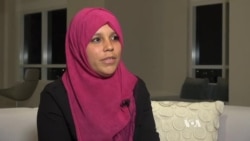Latinos are one of the fastest growing groups in the Muslim religion.
According to the organization whyIslam.org, about 6 percent of American Muslims are Latino.
And according to Latino American Dawah Organization (LADO), a group that promotes Latino conversions, a little more than half of new converts are female.
Greisa Torres arrived in Miami four years ago from Cuba.
While she felt at home in the Florida city, where two out of the three residents are Hispanic, Torres says she lost her identity in the move and found it in the Prophet Muhammad.
Converted during pregnancy
While she was pregnant with her second son, Mahdi, Torres converted to Islam.
“It was very hard for me because we do not have family here, just my husband and my kids. On this day, my baby -- Mahdi -- he was going to be born. That is why I convert to Islam because I was scared," Torres says.
According to some estimates, there are 3,000 Hispanic Muslims in Miami and more than 40,000 nationwide.
Stephanie Londono has a master's degree from Florida International University and has published a study about religious conversions by Latinas.
Londono says some women turn to Islam because they are repelled by Western values of success -- as measured by careers, schooling or wealth. She says they are more comfortable with traditional gender roles.
On any Friday afternoon, juma prayers are held at Masjid Miami Gardens -- the local Islamic mosque.
The men listen to the Imam speak downstairs. The women are separated and watch upstairs, through a glass barrier at the front or on a monitor mounted in the upper corner of the expansive carpeted room.
Gives them guidance
Londono says her research found that some people might view Islam as giving women less freedom, but the converting Latinas see it as a positive change.
“It defines their world on a clear grid of what’s permitted or 'halal,' and what’s prohibited which is 'haram.' So they know exactly where they stand," Londono says. "So the Koran becomes this guidebook that tells you exactly what to wear, what to eat, how to wash, how to behave, when to pray.”
While feminist Muslims might avoid the hijab, many Latinas embrace it.
Londono says they purposely speak Spanish while wearing the scarf to take a stand as a representative of Islam.
Torres agrees, saying, “When people see you with the hijab, they respect you first. Second, it’s the emotion you feel because you are different. You believe in something. It’s amazing.”
Breaking stereotypes
Also, going out in public with the hijab breaks traditional stereotypes that all Arabs are Muslim and all Hispanics are Catholic.
In her transition from Jesus to Muhammed, Torres also discovered similarities in the cultures, such as about 4,000 Spanish words have their roots in Arabic -- virtually all words starting with the letters “a-l.” This dates back to the Moorish occupation of Spain in the Middle Ages.
Torres finds that useful, because some of what she's learning about Islam is taught in Arabic.










